Small mammals of Yellowstone National Park facts for kids
Yellowstone National Park is a special place, home to many amazing animals! While you might think of bears and wolves, there are also at least 50 different kinds of small mammals living here. These animals are super important to the park's ecosystem, even if they are tiny. They live in all sorts of places, from thick forests to open grasslands and along rivers.
This guide will introduce you to some of the cool small mammals you might find in Yellowstone, from clever raccoons to speedy hares and tiny shrews. Each animal has its own unique habits and favorite spots to live.
Contents
- Meet the Small Mammals of Yellowstone
- Raccoons: Clever Critters
- Badgers and Weasels: Speedy Hunters
- Skunks: Stinky but Shy
- Hares and Rabbits: Hopping Around
- Pikas: Little Haymakers
- Shrews: Tiny and Busy
- Beavers: Nature's Engineers
- Squirrels: Acrobats of the Forest
- Pocket Gophers: Underground Diggers
- Mice: Small and Speedy
- Jumping Mice: Long-tailed Leapers
- Muskrats, Voles, and Woodrats: Diverse Rodents
- Porcupines: Spiky Defenders
- Bats: Nighttime Flyers
Meet the Small Mammals of Yellowstone
Raccoons: Clever Critters
Order: Carnivora (Meat-eaters) Family: Procyonidae (Raccoon family)
- Raccoon, Procyon lotor: These smart animals are rare in Yellowstone. They like to live near rivers and cottonwood trees, often looking for food at night.
Badgers and Weasels: Speedy Hunters
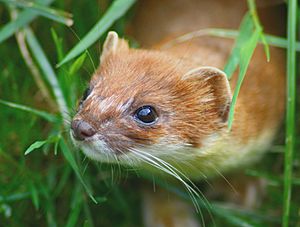
Order: Carnivora (Meat-eaters) Family: Mustelidae (Weasel family)
This family includes many quick and agile hunters.
- American badger, Taxidea taxus: Badgers are common in Yellowstone's sagebrush areas. They are known for their strong claws, which they use to dig burrows and hunt prey.
- Fisher, Martes pennanti: These forest dwellers are very rare, if they are found in the park at all. They are skilled climbers.
- American marten, Martes americana: Common in coniferous forests, martens are agile tree climbers that hunt small animals.
- American mink, Neovison vison: You might spot a mink near rivers. They are good swimmers and hunt fish and other water creatures.
- North American river otter, Lontra canadensis: Otters are playful and common in Yellowstone's rivers, lakes, and ponds. They love to swim and slide!
- Long-tailed weasel, Mustela frenata: Common in many habitats, from willows to spruce forests, these long, slender weasels are fast hunters.
- Short-tailed weasel, Mustela erminea: Also common, these small weasels are quick and can change their fur color to white in winter.
- Wolverine, Gulo gulo: Wolverines are very rare and live in the park's high alpine and coniferous forests. They are known for being tough and powerful.
Skunks: Stinky but Shy
Order: Carnivora (Meat-eaters) Family: Mephitidae (Skunk family)
- Striped skunk, Mephitis mephitis: Skunks are rare in Yellowstone. They prefer areas near rivers and forests and are famous for their strong-smelling spray.
Hares and Rabbits: Hopping Around
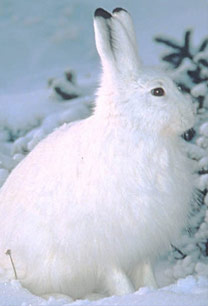
Order: Lagomorpha (Hares, rabbits, and pikas) Family: Leporidae (Hare and rabbit family)
These furry animals are common throughout the park.
- Snowshoe hare, Lepus americanus: Common in forests and willow areas, snowshoe hares have large feet that help them move on snow.
- White-tailed jackrabbit, Lepus townsendii: Common in sagebrush and grasslands, these hares are known for their long ears and fast running.
- Desert cottontail, Sylvilagus audubonii: Common in shrub lands, these rabbits are often seen at dawn and dusk.
- Mountain cottontail, Sylvilagus nuttallii: Also common in shrub lands, they are similar to desert cottontails but live at higher elevations.
Pikas: Little Haymakers
Order: Lagomorpha (Hares, rabbits, and pikas) Family: Ochotonidae (Pika family)
- American pika, Ochotona princeps: Pikas are common on rocky slopes. These small, furry animals collect plants and dry them for winter food, making "haypiles."
Shrews: Tiny and Busy
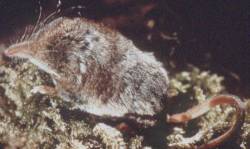
Order: Soricomorpha (Shrews and moles) Family: Soricidae (Shrew family)
Shrews are some of the smallest mammals in Yellowstone, always busy looking for food.
- Dusky shrew, Sorex monticolus: Common in moist meadows and forests.
- Masked shrew, Sorex cinereus: Also common in moist meadows and forests.
- American water shrew, Sorex palustris: Common in moist areas near water.
- Preble's shrew, Sorex preblei: Rare, if present, in moist meadows and forests.
- Dwarf shrew, Sorex nanus: Rare in moist meadows and forests, this is one of the smallest mammals in North America.
Beavers: Nature's Engineers
Order: Rodentia (Rodents) Family: Castoridae (Beaver family)
- Beaver, Castor canadensis: Beavers are common in Yellowstone's ponds and streams. They are famous for building dams and lodges, changing the landscape around them. There are about 500 beavers in the park.
Squirrels: Acrobats of the Forest

Order: Rodentia (Rodents) Family: Sciuridae (Squirrel family)
This family includes many familiar and active animals.
- Least chipmunk, Tamias minimus: Common in forests, these are the smallest chipmunks.
- Uinta chipmunk, Tamias umbrinus: Also common in forests.
- Yellow-pine chipmunk, Tamias amoenus: Common in forests.
- Yellow-bellied marmot, Marmota flaviventris: Common on rocky slopes, marmots are large ground squirrels that often whistle to warn others of danger.
- Golden-mantled ground squirrel, Callospermophilus lateralis: Common in forests and rocky slopes, they look a bit like chipmunks but don't have stripes on their faces.
- Northern flying squirrel, Glaucomys sabrinus: Occasional in forests, these squirrels don't truly fly but glide between trees using a special skin flap.
- American red squirrel, Tamiasciurus hudsonicus: Common in forests, these noisy squirrels are known for collecting pine cones.
- Uinta ground squirrel, Urocitellus armatus: Common in sagebrush and meadows.
Pocket Gophers: Underground Diggers
Order: Rodentia (Rodents) Family: Geomyidae (Pocket gopher family)
- Northern pocket gopher, Thomomys talpoides: Common in sagebrush, meadows, and forests. These animals spend most of their lives underground, digging tunnels with their strong claws and teeth.
Mice: Small and Speedy
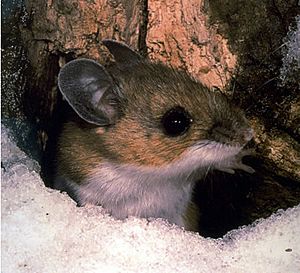
Order: Rodentia (Rodents) Family: Cricetidae (Cricetid rodent family)
- Deer mouse, Peromyscus maniculatus: Deer mice are very common in grasslands and are known for their large eyes and ears.
Jumping Mice: Long-tailed Leapers
Order: Rodentia (Rodents) Family: Dipodidae (Jumping mouse family)
- Western jumping mouse, Zapus princeps: Occasional in areas near water, these mice have very long tails and can make impressive leaps.
Muskrats, Voles, and Woodrats: Diverse Rodents
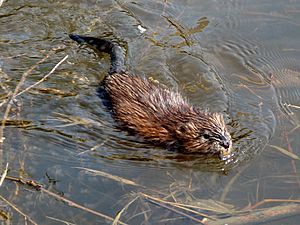
Order: Rodentia (Rodents) Family: Cricetidae (Cricetid rodent family)
This family includes a variety of rodents, each with unique habits.
- Muskrat, Ondatra zibethicus: Common in streams, lakes, and ponds, muskrats are semi-aquatic rodents that build lodges similar to beavers, but smaller.
- Western heather vole, Phenacomys intermedius: Occasional in habitats from sagebrush to forests.
- Long-tailed vole, Microtus longicaudus: Common in moist meadows.
- Meadow vole, Microtus pennsylvanicus: Common in moist meadows.
- Montane vole, Microtus montanus: Common in moist meadows.
- Southern red-backed vole, Myodes gapperi: Common in dense forests.
- Water vole, Microtus richardsoni: Occasional in areas near water.
- Bushy-tailed woodrat, Neotoma cinerea: Common on rocky slopes, these "packrats" are known for collecting shiny objects and other items for their nests.
Porcupines: Spiky Defenders
Order: Rodentia (Rodents) Family: Erethizontidae (New World porcupine family)
- North American porcupine, Erethizon dorsatum: Common in forests, sagebrush, and willows, porcupines are famous for their sharp quills, which they use for defense.
Bats: Nighttime Flyers
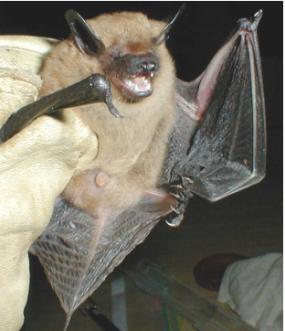
Order: Chiroptera (Bats) Family: Vespertilionidae (Vespertilionid bat family)
Bats are the only mammals that can truly fly! They are active at night, hunting insects.
- Big brown bat, Eptesicus fuscus: Common, these bats often roost in sheltered areas like caves or buildings.
- Fringe-tailed bat, Myotis thysanodes: Uncommon, they roost in cliffs and large dead trees.
- Hoary bat, Lasiurus cinereus: Uncommon, these bats often roost hidden in trees.
- Little brown bat, Myotis lucifugus: Common, they roost in caves, buildings, and trees.
- Long-eared bat, Myotis evotis: Uncommon, they roost in cliffs and buildings.
- Long-legged bat, Myotis volans: Common, they roost in tree cavities, cliffs, and buildings.
- Silver-haired bat, Lasionycteris noctivagans: Common, they roost in trees, including dead ones.
- Western small-footed bat, Myotis ciliolabrum: Rare, if present, they roost in rocky areas and caves.
- Townsend's big-eared bat, Corynorhinus townsendii: Uncommon, these bats are known for their very large ears and roost in caves.
- Yuma bat, Myotis yumanensis: Rare, if present, they roost in caves, buildings, and trees.

